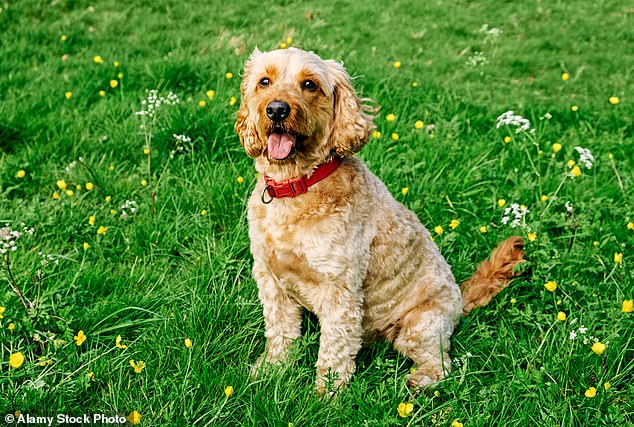I’m a dog trainer – these are the five signs your ‘pandemic pup’ has separation anxiety and how to snap them out of it
Lorna Winter is a dog trainer and co-founder of puppy training app ZigZag (ZigZag)
People who bought ‘pandemic puppies’ are now seeing signs of separation anxiety as more people return to full-time office work, an expert has warned.
Lorna Winter, dog trainer and co-founder of puppy training app ZigZag, says owners are facing a double whammy.
Those dogs will now also be going through puberty, and their anxiety will likely get worse, she said.
Winter said it’s easy to fall into the trap of thinking that anxiety-related behavior is problematic (nearly 20 percent of dog owners would consider giving up their animal because of it, Zigzag‘s research found).
But in most cases, there are simple steps to take to deal with an anxious dog — whatever the cause of his anxiety, Winter said.
Forgot commands
If your dog has forgotten commands he has been trained to obey, this could be a warning sign of anxiety, Winter said.
Winter said: ‘When a dog is anxious, he can sometimes enter a state called ‘learned helplessness’, which can give the impression that he is being aloof or ignoring commands.
‘In cases of separation anxiety, your dog may have been so panicked while you were away that when you return; they’re pretty much closed.”

Does your dog ever forget commands?
Whining when you leave the room
Barking or whining when you leave the room can be a sign of anxiety, especially separation anxiety, says Winter.
Winter said, “Does your puppy bark a lot when you leave the house? Or whining even when you leave the room?
‘These are all signs that your puppy could have separation anxiety, a catch-all term used to describe when a dog finds it challenging to be alone.
‘This fear often surfaces when they are alone and fearful of being abandoned.’
Winter recommends going to the door randomly throughout the day to get your dog used to the idea, then opening and closing the door for the next three days.
Winter says, “Then go outside for a few seconds and leave the door on the latch—you don’t want your pup to make any associations with it yet.” Then start increasing the time
Make your entrances and exits as worry-free as possible. Help your puppy understand that this is part of the daily norm and build it up slowly!’
To dig
Digging is a “displacement behavior” that provides dogs with a sense of comfort when they’re feeling anxious, Winter says.
She says, “Consider taking the first step by eliminating any potential stressors that could trigger their desire to dig. It is possible that they are signaling their discomfort and expressing a desire for a change of environment.’
She also points out that some breeds are more prone to digging when anxious or excited, including dachshunds, beagles and most herding and working breeds.

Dachshunds like to dig with other breeds, Winter says
She says you can turn a dog’s fear into play by providing fun ways to dig, such as filling a child’s sandbox with dirt or dog-safe sand and hiding toys in it to encourage digging.
She says: ‘You can also try cutting down the sides of a large cardboard box and filling it with rolled up packing material, then scattering some treats to encourage them to dig and find them. Voilà, you’ve created a foraging box or covered digging hole.
‘Also, make sure there are plenty of blankets in their bed so they can create a nest to snuggle into when they need to.’
Chewing on shoes
Chewing on couches, shoes and doors usually comes down to anxiety or boredom, says Winter.
She says: ‘This habit of chewing comes from a reliable, self-soothing instinct that makes them feel good, because chewing triggers the release of endorphins such as dopamine and serotonin in their brain.
‘Consider offering your pup a safe chew toy, something he can sink his teeth into and relieve some of the stress and anxiety he may be feeling. Just like stress balls for humans, these toys are great for releasing pent-up anxious energy and hopefully stopping the bank’s destruction!’
Winter recommends keeping an eye on your dog via a webcam when you’re not home.
She said: ‘It’s always a good idea to keep an eye on your dog via camera when you’re not at home. Do they look sad during their destructive escapades, or do you notice other signs of distress? In such cases, it may be helpful to delve into a separation anxiety protocol to ease their distress while you are away.
‘However, if it seems like they are having a party of their own in your absence, then increasing their daily mental and physical stimulation is a wise move!’
Going to the toilet indoors
Most puppies have small bladders and limited control, so it’s normal for them to have “spontaneous bathroom breaks,” says Winter.
She said: ‘If your pup consistently uses the indoor facilities when you’re not there or at night, he’s probably dealing with separation anxiety.
‘Puppies thrive on routines and find comfort in the predictability of playtime, walks and meals.
“Setting up a schedule can do wonders for both separation anxiety and toilet training.”
